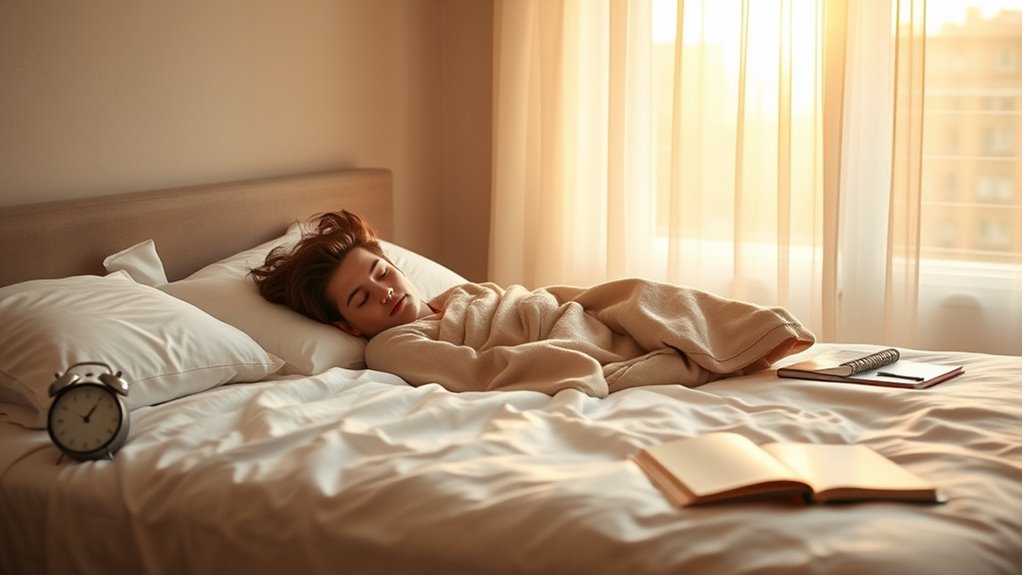To find your sleep chronotype, pay attention to when you naturally feel most energetic and when you prefer to sleep and wake. Morning larks wake early and thrive with early routines, while night owls feel best later in the day and prefer to go to bed late. Aligning your schedule with your inner clock boosts energy and improves sleep quality. Keep exploring how adjusting light exposure and routines can help you hack your schedule for maximum vitality.
Key Takeaways
- Identify your chronotype through questionnaires or observing your natural energy and sleep patterns.
- Align your daily schedule with your biological clock by adjusting wake and sleep times accordingly.
- Maximize morning light exposure to reinforce your circadian rhythm and improve alertness.
- Minimize artificial blue light at night to promote melatonin production and better sleep quality.
- Consistently follow your tailored routine to enhance energy levels and overall well-being.

Have you ever wondered why some people feel most alert in the morning while others hit their stride late at night? The answer lies in your sleep chronotype, which is your natural biological rhythm that influences when you feel most awake and when you’re ready to sleep. Your body’s internal clock, known as your circadian rhythm, governs this pattern. A key player in this cycle is melatonin production, a hormone that signals your body to prepare for sleep. If your melatonin production peaks too early or too late, it can cause circadian misalignment, throwing off your natural schedule and making you feel out of sync with the world around you. This misalignment can lead to trouble falling asleep, waking up feeling groggy, or struggling to stay alert during the day.
Understanding your chronotype helps you tailor your schedule to match your body’s natural tendencies. Some people are naturally morning larks, feeling energized early and ready to wind down at night. Others are night owls, thriving after sunset and finding mornings challenging. Recognizing where you fall on this spectrum allows you to optimize your daily routines. If you’re an evening person, pushing yourself to wake up early might leave you feeling unrested and unproductive. Conversely, if you’re a morning person, staying up late can disrupt your sleep cycle and reduce your overall energy.
One of the biggest influences on your circadian rhythm is light exposure, which directly impacts melatonin production. Bright morning light can help reset your internal clock, especially if you’re experiencing circadian misalignment. Conversely, exposure to artificial light at night, especially blue light from screens, suppresses melatonin and delays sleep onset. This suppression can shift your internal clock later, making it harder to fall asleep at a reasonable hour and compromising your sleep quality. To align your schedule with your natural rhythm, aim for bright light during the day and dim, low-light environments in the evening. Additionally, the use of eye patches containing beneficial ingredients like collagen and hyaluronic acid can help soothe tired eyes and promote relaxation before sleep.
Adjusting your habits to fit your chronotype isn’t just about feeling more rested; it’s about optimizing your energy levels throughout the day. When your sleep aligns with your circadian rhythm, your body produces melatonin at the right times, helping you fall asleep faster and wake up refreshed. Avoid circadian misalignment by maintaining consistent sleep and wake times, especially on weekends, and managing light exposure carefully. By understanding and respecting your biological clock, you can hack your schedule for better energy, improved mood, and overall well-being.
Frequently Asked Questions
Can Chronotypes Change Over a Lifetime?
You might wonder if your chronotype evolution is possible over time. Yes, it can change, influenced by lifestyle factors like work schedule, age, and habits. While genetics play a role, your daily routines and environment profoundly impact your internal clock. By adjusting your lifestyle, you can shift your sleep patterns and optimize your energy levels, making it possible to adapt your chronotype throughout your life.
How Do I Identify My Sleep Chronotype Accurately?
To identify your sleep chronotype accurately, observe your sleep patterns over a week, noting when you naturally feel most alert and sleepy. Pay attention to your biological rhythms, like peak energy times and preferred wake and sleep times. Keep a sleep journal or use a tracking app to record these patterns. This helps reveal whether you’re a morning lark, night owl, or somewhere in between, aligning your schedule with your natural biological rhythms.
Are There Specific Foods That Support My Chronotype?
You wonder if certain foods support your chronotype. Focus on diet compatibility by choosing meals that align with your natural energy rhythms. For example, early risers may benefit from a protein-rich breakfast, while night owls might prefer lighter dinners. Pay attention to meal timing, eating during your peak alertness for better digestion and energy. Adjust your diet to match your body’s schedule, helping you feel more balanced and energized throughout the day.
What Are the Best Workout Times for Different Chronotypes?
You should tailor your workout times to your natural energy peaks. Morning routines work best for morning chronotypes, boosting energy and focus early in the day. Evening workouts suit evening chronotypes, helping you wind down and stay motivated. If you’re an intermediate chronotype, mix morning and evening sessions. Pay attention to how your body feels, and adjust your workout timing to optimize your energy levels and overall performance.
How Does Shift Work Affect Different Sleep Chronotypes?
Imagine trying to dance to a rhythm that keeps changing—that’s what shift work does to your sleep chronotype. It disrupts your natural sleep pattern, causing sleep disruption, especially if your body’s internal clock isn’t aligned with irregular hours. For some, night owls, night shifts may feel natural, but early birds struggle. Understanding your chronotype can help you adapt better and minimize the negative effects of shift work.
Conclusion
By discovering your sleep chronotype, you unveil the secret to unstoppable energy and peak productivity. Imagine waking up feeling like a superhero, conquering every challenge with laser focus and boundless vitality. When you hack your schedule to match your natural rhythm, you don’t just improve your days—you transform your entire life into an unstoppable, high-powered adventure. So, find your chronotype, tweak your routine, and watch as your energy skyrockets to levels you never thought possible!









